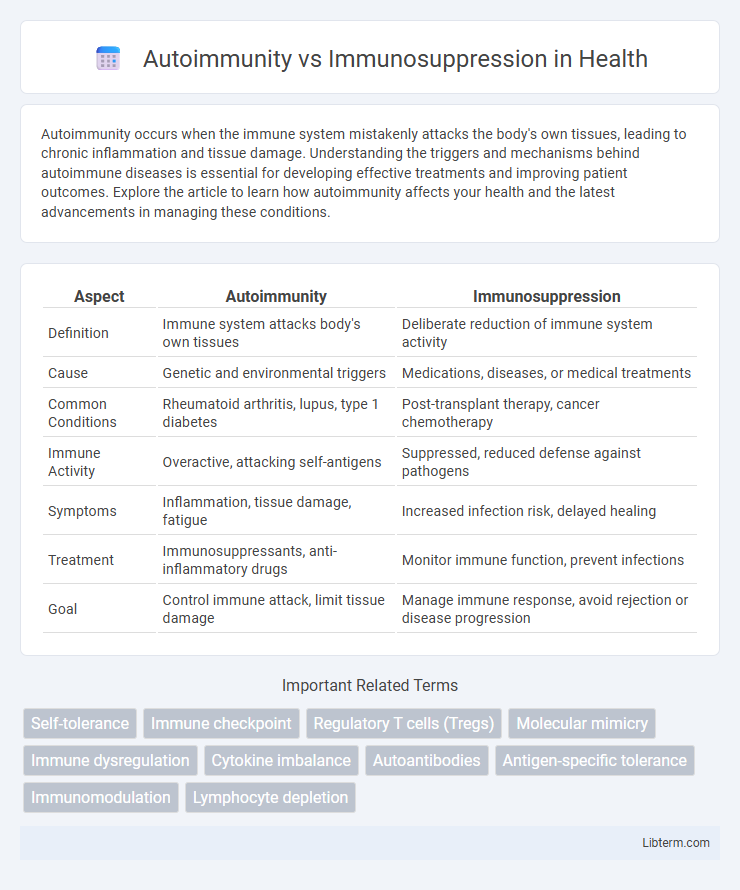Autoimmunity occurs when the immune system mistakenly attacks the body's own tissues, leading to chronic inflammation and tissue damage. Understanding the triggers and mechanisms behind autoimmune diseases is essential for developing effective treatments and improving patient outcomes. Explore the article to learn how autoimmunity affects your health and the latest advancements in managing these conditions.
Table of Comparison
| Aspect | Autoimmunity | Immunosuppression |
|---|---|---|
| Definition | Immune system attacks body's own tissues | Deliberate reduction of immune system activity |
| Cause | Genetic and environmental triggers | Medications, diseases, or medical treatments |
| Common Conditions | Rheumatoid arthritis, lupus, type 1 diabetes | Post-transplant therapy, cancer chemotherapy |
| Immune Activity | Overactive, attacking self-antigens | Suppressed, reduced defense against pathogens |
| Symptoms | Inflammation, tissue damage, fatigue | Increased infection risk, delayed healing |
| Treatment | Immunosuppressants, anti-inflammatory drugs | Monitor immune function, prevent infections |
| Goal | Control immune attack, limit tissue damage | Manage immune response, avoid rejection or disease progression |
Understanding Autoimmunity: Definition and Mechanisms
Autoimmunity occurs when the immune system mistakenly attacks the body's own tissues due to a loss of self-tolerance, leading to chronic inflammatory diseases such as rheumatoid arthritis and type 1 diabetes. Central mechanisms involve autoreactive T cells, autoantibodies produced by B cells, and dysregulation of immune checkpoints that normally prevent self-reactivity. Understanding these processes helps differentiate autoimmune pathology from immunosuppression, where immune responses are deliberately dampened to prevent tissue damage or transplant rejection.
What is Immunosuppression? Types and Causes
Immunosuppression refers to the reduction or inhibition of the immune system's activity, often induced intentionally through medications such as corticosteroids, calcineurin inhibitors, and biologics to prevent organ transplant rejection or treat autoimmune diseases. Types of immunosuppression include primary (genetic defects), secondary (caused by infections like HIV), and iatrogenic (resulting from medical treatments such as chemotherapy or immunosuppressive drugs). Causes vary widely, encompassing congenital immune deficiencies, viral infections that impair immunity, and pharmacological agents designed to modulate immune responses.
Key Differences: Autoimmunity vs Immunosuppression
Autoimmunity occurs when the immune system mistakenly attacks the body's own tissues, causing diseases such as rheumatoid arthritis and lupus, whereas immunosuppression involves the deliberate reduction of immune activity to prevent organ transplant rejection or treat autoimmune diseases. Autoimmune conditions are characterized by hyperactive immune responses, while immunosuppression results in weakened immunity, increasing susceptibility to infections. Understanding these key differences is crucial for developing targeted therapies that either modulate or suppress immune function to maintain health.
Common Autoimmune Diseases and Symptoms
Common autoimmune diseases include rheumatoid arthritis, lupus, multiple sclerosis, and type 1 diabetes, characterized by the immune system attacking the body's own tissues. Symptoms vary widely but often involve chronic inflammation, joint pain, fatigue, skin rashes, and organ dysfunction depending on the specific condition. Immunosuppression, used as a treatment, aims to reduce immune system activity to alleviate these symptoms and prevent tissue damage.
Causes and Risk Factors for Immunosuppression
Immunosuppression occurs due to factors such as genetic disorders, infections like HIV, chronic diseases, and the use of immunosuppressive drugs following organ transplantation or for autoimmune disease management. Environmental exposures, malnutrition, and certain cancers also contribute significantly to weakened immune responses. Understanding these causes and risk factors is crucial for differentiating immunosuppression from autoimmunity, where the immune system mistakenly attacks the body's own tissues.
Immune System Dysfunction: Overactivity vs Underactivity
Autoimmunity results from immune system overactivity, where the body mistakenly attacks its own tissues, leading to diseases such as rheumatoid arthritis and lupus. Immunosuppression involves underactivity of the immune system, reducing its ability to fight infections and increasing vulnerability to opportunistic pathogens. Balancing immune regulation is critical to prevent the pathological consequences of both overactive autoimmune responses and suppressed immune defenses.
Diagnostic Approaches for Autoimmune and Immunosuppressed States
Diagnostic approaches for autoimmune diseases often include the detection of specific autoantibodies such as ANA, anti-dsDNA, and RF through serological tests, alongside inflammatory markers like ESR and CRP to assess disease activity. Immunosuppressed states require evaluation of immune function via lymphocyte subsets analysis, immunoglobulin levels, and assessment of cell-mediated immunity to detect vulnerabilities to infections and immune deficiencies. Advanced imaging and biopsy can support the diagnosis by revealing tissue-specific inflammation or damage characteristic of autoimmune or immunodeficient conditions.
Treatment Strategies: Managing Autoimmunity vs Addressing Immunosuppression
Treatment strategies for autoimmunity focus on modulating immune system hyperactivity using immunosuppressive agents such as corticosteroids, biologics targeting specific cytokines, and disease-modifying antirheumatic drugs (DMARDs) to prevent tissue damage. In contrast, managing immunosuppression involves restoring immune function through strategies like reducing immunosuppressive medication doses, administering immunostimulants, or utilizing hematopoietic stem cell transplantation to enhance immune competence. Tailoring therapies requires precise diagnosis and biomarker assessment to balance immune activation and suppression effectively, minimizing risks of infection or autoimmune flare-ups.
Lifestyle Considerations and Patient Care
Managing autoimmunity requires lifestyle adjustments such as adopting an anti-inflammatory diet, regular moderate exercise, and stress reduction techniques to modulate immune system activity without triggering flares. Immunosuppression therapy demands careful patient care, including infection prevention strategies, routine monitoring of immune function, and adherence to medication regimens to balance therapeutic benefits and adverse effects. Personalized care plans that incorporate patient education on symptom tracking and lifestyle modifications optimize treatment outcomes in both autoimmune and immunosuppressed individuals.
Future Directions in Autoimmunity and Immunosuppression Research
Future directions in autoimmunity and immunosuppression research emphasize the development of targeted biologics and personalized medicine approaches to modulate immune responses without compromising overall immunity. Advances in genomics and proteomics enable identification of novel biomarkers for early detection and precise intervention in autoimmune diseases. Novel immunomodulatory therapies focus on restoring immune tolerance through regulatory T cell enhancement and checkpoint inhibitor optimization, aiming to reduce side effects associated with broad immunosuppression.
Autoimmunity Infographic

 libterm.com
libterm.com